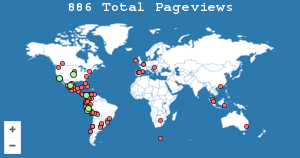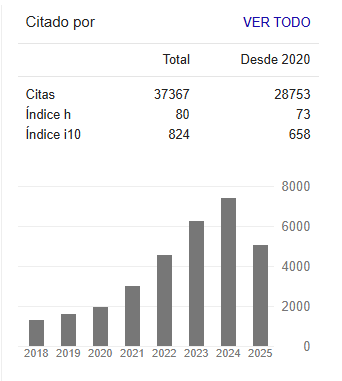Analysis of trends in research on internationalization and production chains in the pork sector
Resumen
The pig sector has shown sustained growth in the last thirteen years in Latin America, which is why it is of special importance for these economies. This article explores trends in research on internationalization and production chains in the pig sector. For this purpose, a network analysis of keyword co-occurrences was developed, which allowed visualizing the state of development of research in the field. Four clusters or thematic groups were identified that summarize the areas addressed in the research on internationalization and production chains in the pig sector: pig industry market, supply chain management and animal welfare, sustainable development in the pig industry and human welfare in the pig industry.
Citas
Banco Mundial. (2020). Análisis económico 333 Latinoamérica. Disponible en https://www.bancomundial.org/es/region/lac/overview
Barberis, E., Freddi, D., Giammetti, R., Polidori, P., Teobaldelli, D., & Viganò, E. (2020). Trade Relationships in the European Pork Value Chain: a Network Analysis. Economia Agro-Alimentare Food Economy - Open Access, 22(1). https://doi.org/10.3280/ecag1-2020oa10070
Cárdenas, G., Maldonado, E., Valdez, S., Sarduy, P., y Dieguez, S. (2019). La producción más limpia en el sector porcino: Una experiencia desde la Amazonía ecuatoriana. Anales Científicos, 80(1), 76-91. https://doi.org/10.21704/ac.v80i1.1288
Chen, X., Chen, Y., Liu, X., Li, Y., & Wang, X. (2021). Investigating historical dynamics and mitigation scenarios of anthropogenic greenhouse gas emissions from pig production system in China. Journal of Cleaner Production, 296, 126572. https://doi.org/10.1016/j.jclepro.2021.126572
Dai, X. W., Zhanli, S. U. N., & Müller, D. (2021). Driving factors of direct greenhouse gas emissions from China’s pig industry from 1976 to 2016. Journal of Integrative Agriculture, 20(1), 319-329. https://www.econstor.eu/handle/10419/227596
Duvaleix, S., Lassalas, M., Latruffe, L., Konstantidelli, V., & Tzouramani, I. (2020). Adopting environmentally friendly farming practices and the role of quality labels and producer organisations: a qualitative analysis based on two European case studies. Sustainability, 12(24), 10457. https://doi.org/10.3390/su122410457
Organización de las Naciones Unidas para la Alimentación y la Agricultura- FAO (2020). Estadísticas de Comercio Exterior. https://www.fao.org/faostat/es/#data/TCL.
Fondo Nacional de la Porcicultura – Porkolombia. (2022). Estadísticas sectoriales. Disponible en https://porkcolombia.co/estadisticas-sectoriales/
Fousekis, P., & Tzaferi, D. (2022). Tail price risk spillovers along the US beef and pork supply chains. Australian Journal of Agricultural and Resource Economics, 66(2), 383-399. https://doi.org/10.1111/1467-8489.12455
Gálvez, C. (2018). El campo de investigación del Análisis de Redes Sociales en el área de las Ciencias de la Documentación: un análisis de co-citación y co-palabras. Revista general de información y documentación, 28(2), 455. https://dialnet.unirioja.es/servlet/articulo?codigo=6806327
Guo, J., & Tanaka, T. (2022). Potential factors in determining cross-border price spillovers in the pork sector: Evidence from net pork-importing countries. Humanities and Social Sciences Communications, 9(1), 1-14.
Herrera, M. M., & Trujillo-Díaz, J. (2022). Towards a strategic innovation framework to support supply chain performance. International Journal of Productivity and Performance Management, 71(5), 1872–1894. https://doi.org/10.1108/ijppm-03-2020-0131
Huan, C., Xu, Y., Zhang, W., Pan, H., Zhou, Z., Yao, J., ... & Gao, S. (2022). Hippophae rhamnoides polysaccharides dampen pseudorabies virus infection through downregulating adsorption, entry and oxidative stress. International Journal of Biological Macromolecules, 207, 454-463. https://doi.org/10.1016/j.ijbiomac.2022.03.041
Iglesias, R. A., Ortíz, M. A., Juárez, M. M., Guevara, G. J., y Córdova, I. A. (2017). Comportamiento de la porcicultura mexicana de los años 1970 a 2017. Una revisión documental sobre su desempeño. Sociedades Rurales, Producción y Medio Ambiente, (34), 153-168. https://sociedadesruralesojs.xoc.uam.mx/index.php/srpma/article/view/338
Ji, C., Jin, S., Wang, H., & Ye, C. (2019). Estimating effects of cooperative membership on farmers’ safe production behaviors: Evidence from pig sector in China. Food Policy, 83, 231-245.
Ken, I., & León, K. S. (2022). Regulatory theater in the pork industry: how the capitalist state harms workers, farmers, and unions. Crime, Law, and Social Change, 78(5), 599–619. https://doi.org/10.1007/s10611-022-10019-0
Klein, O. (2018). Transnational networks of pork production: Fragile linkages between Germany and CEE countries. European Spatial Research and Policy, 25(1), 93-111.
McEwan, K., Marchand, L., Shang, M., & Bucknell, D. (2020). Potential implications of COVID-19 on the Canadian pork industry. Canadian Journal of Agricultural Economics/Revue canadienne d’agroeconomie, 68(2), 201-206.
Nakamura, K., & Itsubo, N. (2019). Carbon and water footprints of pig feed in France: Environmental contributions of pig feed with industrial amino acid supplements. Water Resources and Industry, 21, 100108. https://doi.org/10.1016/j.wri.2019.100108
Ni, Z. H. U. O., Chen, J. I., & DING, J. Y. (2020). Pig farmers’ willingness to recover their production under COVID-19 pandemic shock in China–Empirical evidence from a farm survey. Journal of Integrative Agriculture, 19(12), 2891-2902. https://doi.org/10.1016/S2095-3119(20)63411-6
Piot-Lepetit, I., & Moing, M. L. (2007). Productivity and environmental regulation: the effect of the nitrates directive in the French pig sector. Environmental and Resource Economics, 38(4), 433-446. https://link.springer.com/article/10.1007/s10640-007-9086-7
Rebollar, R. S., Hernández, M. J., y Rebollar, R. E. (2022). Modelo econométrico de demanda de carne porcina en México, 1990-2019. CIENCIA Ergo-Sum, 29(3). https://doi.org/10.30878/ces.v29n3a1
Rodriguez, M. R., Besteiro, R., Ortega, J. A., Fernandez, M. D., & Arango, T. (2022). Evolution and Neural Network Prediction of CO2 Emissions in Weaned Piglet Farms. Sensors, 22(8), 2910. https://www.mdpi.com/1424-8220/22/8/2910
Shang, X., & Tonsor, G. T. (2019). Sanitary and phytosanitary regulations and international red meat trade. British Food Journal (Croydon, England), 121(10), 2309–2321. https://doi.org/10.1108/bfj-10-2018-0663
Uzea, A. D., Hobbs, J. E., & Zhang, J. (2011). Activists and animal welfare: Quality verifications in the Canadian pork sector. Journal of Agricultural Economics, 62(2), 281-304.
Van Eck, N. J., & Waltman, L. (2014). Visualizing bibliometric networks. In Measuring scholarly impact (pp. ٢٨٥-٣٢٠). Springer, Cham.
Vargas-Quesada, B., & de Moya-Anegón, F. (2007). Visualizing the structure of science. Springer Science & Business Media.
Wang, C. M. (2022). Securing participation in global pork production networks: biosecurity, multispecies entanglements, and the politics of domestication practices. Journal of Cultural Economy, 15(2), 200-215. https://doi.org/10.1080/17530350.2021.2018346
Weersink, A., von Massow, M., & McDougall, B. (2020). Economic thoughts on the potential implications of COVID-19 on the Canadian dairy and poultry sectors. Canadian Journal of Agricultural Economics/Revue canadienne d’agroeconomie, 68(2), 195-200. https://doi.org/10.1111/cjag.12240
Wognum, N., Trienekens, J., Wever, M., Vlajic, J., Van der Vorst, J. G. A. J., Omta, O., ... & Nguyen, T. L. T. (2009). Organisation, logistics and environmental issues in the European pork chain. European pork chains: Diversity and quality challenges in consumer-oriented production and distribution, 41-72. https://research.wur.nl/en/publications/organisation-logistics-and-environmental-issues-in-the-european-p
Xie, Q., Ni, J. Q., Li, E., Bao, J., & Zheng, P. (2022). Sequential air pollution emission estimation using a hybrid deep learning model and health-related ventilation control in a pig building. Journal of Cleaner Production, 371, 133714. https://doi.org/10.1016/j.jclepro.2022.133714
Yoo, S., Jang, S., Byun, S. W., & Park, S. (2019). Exploring human resource development research themes: A keyword network analysis. Human Resource Development Quarterly, 30(2), 155–174. https://doi.org/10.1002/hrdq.21336

Esta obra está bajo licencia internacional Creative Commons Reconocimiento-NoComercial-CompartirIgual 4.0.








.png)






























